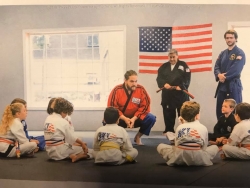

The importance of having an instructor development program in your dojo
Many of us have had similar experiences on the mat. Putting on a uniform and running through the material. Along the way, we learn how to execute those techniques with precision and accuracy. The very idea of martial arts training is that it takes years to become proficient with certain techniques and ideas of movement. Repetition is key to our success in building muscle memory which allows us to be able to defend ourselves quickly and decisively. There is only one facet to training that we tend to leave students to sort out for themselves: teaching.
My initial introduction to teaching is a common story. I was a student who came to their classes and worked hard, my instructor recognized that in me and invited me to start assisting with classes. My first time assisting, I walked out onto the mat, was introduced to the students by the instructor leading the class and after that, I proceeded to walk around nodding my head and uttering very few critiques. I was unsure of my role as an assistant and at the time, we were told “watch me teach, pick up what I do, and try to emulate it”. Advanced students were invited to assist with classes and those that showed promise were hired on as paid employees. There was little training on teaching and coaching. We were encouraged to pay attention to coaching when we were coached in class and how the material was broken down when taught in our classes, but we were not on any sort of training regimen to be better teachers.
The idea that we were higher rank so we could teach was not an ideal way to look at developing a solid and positive teaching team. Personal comprehension of material does not necessarily mean that someone has learned the most effective way to communicate that material to others. I encourage you to look past the personal knowledge and skill set of a person when determining who is fit for teaching and who isn’t. An intermediate-ranked student with a higher level of skill in communication will be able to encourage students and help refine their material better than a black belt who is unable to effectively communicate the material in a way the student can understand effectively.
In our dojo, we assign separate ranks for teaching ability. While these are not belt rankings, they are still an integral part of developing a strong, passionate, and humble team of instructors. Breaking away from the mentality that all Black Belts can teach proved to be a beneficial change for my team and our school. Below are a few steps to help you begin to establish a more formal and dedicated instructor development system in your school.
1) Define the role of your Instructors
The role of instructors is important to establish. It creates boundaries, expectations, and organization. The system that we use contains seven levels of an instructor, beginning with an assistant helper and ending with Owner. This psychologically will help everyone feel included on the team because that’s an important feeling to create a sense of unity in the teaching team. The other benefit to this would be that people can see a long-term sense of progression into starting their own schools someday. If people see a viable path for them for growth, they can see the opportunity to grow into a full-time instructor role.
2) Set the expectation for your team
Setting an expectation for your team is an integral part of an instructor development system. Establish the curriculum they will be learning, coupled with testing and regular check-in meetings with the team as a whole and individually. Each level of instructor has a specific job that they need to focus on. Assistant helpers are responsible for gathering equipment and helping tie loose belts, Junior instructors are responsible for helping groups with the directions and giving positive affirmations to each participant in the class. Lead instructors are responsible for creating a lesson plan and correcting material and so on…
3) Make it fun!
This is the most important beginning step for developing strong and positive instructors. As instructors, we are stewards of the arts and it is our responsibility to make sure the skills and lessons are passed onto the next generation, however, I believe that the students will learn better through their enjoyment and the fun that Martial Arts training provides. I am not saying that instructors should be comedians and that the classes should have no substance, quite the opposite. I believe that we can teach fun and exciting classes while still maintaining a high expectation of behavior and decorum from our students. If you train your instructors only in the “science of teaching” and in a very stern manner, they will teach that way and become less relatable to the younger students. You can be approachable while still holding people to a high standard. When developing new instructors make the training fun and exciting, this will spark their creativity and motivate them.
In conclusion, having a strong instructor development program will ensure that the martial arts endure for generations to come. Defining our role as Martial Arts Educators, we can have a tremendous impact on what it means to be a Martial Artist in the 21st century. It is our responsibility to ensure that we are providing the highest level of education to our students and that starts by ensuring that we are looking at teaching ability as opposed to a person’s ranking in the arts.
- A 21st Century Instructor - August 31, 2021
- The Dojo, where everyone knows your name - April 7, 2021
- Black Belt Student, White Belt Teacher - March 18, 2021

Leave a Reply